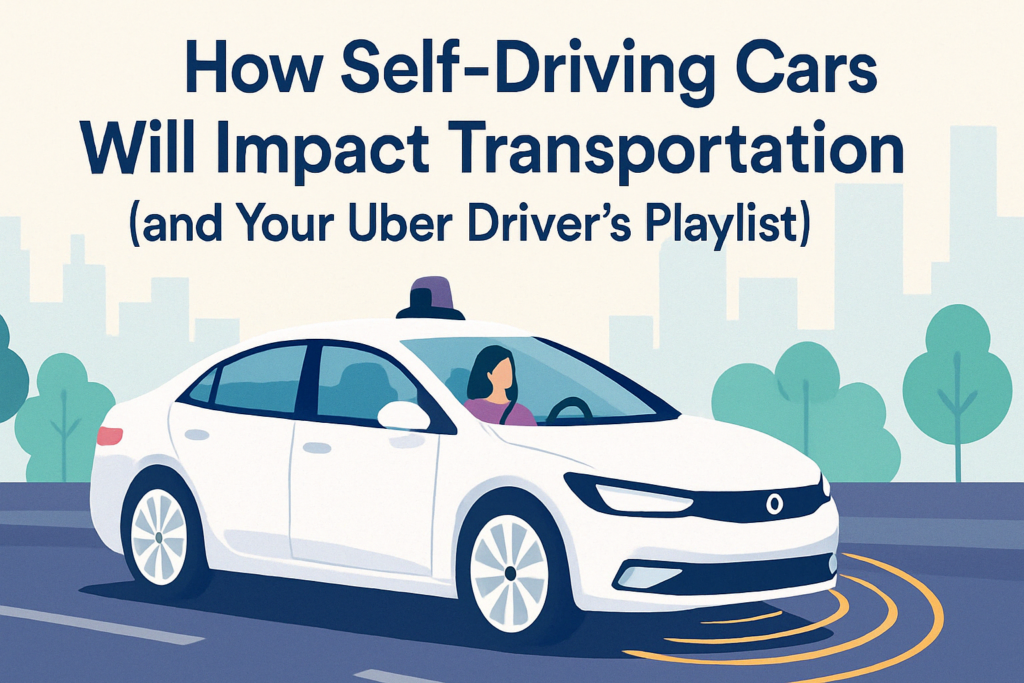Last week, I sat in traffic behind a guy eating cereal out of a mixing bowl. Not a to-go cup. A full-on mixing bowl with a spoon the size of a shovel. That’s when it hit me: we might actually need self-driving cars—not because they’re cool, but because humans clearly can’t be trusted behind the wheel.
Self-driving cars, or autonomous vehicles if you’re feeling fancy, are about to shake up transportation like a squirrel loose in a Tesla showroom. We’re talking less road rage, fewer parking wars, and maybe—just maybe—no more Uber drivers who insist on explaining crypto while blasting house music.
Your Commute Is About to Get Weirdly Quiet
Right now, driving involves a lot of multitasking: steering, braking, swearing at other drivers. But autonomous vehicles? They don’t flip people off, or try to beat yellow lights like it’s an Olympic event. They just… drive. Predictably. Carefully. Almost boringly.
And boring, in this case, is glorious.
With self-driving cars, commutes become something else entirely. You could nap. Read. Or binge that true crime podcast without worrying you’ll miss an exit and end up in a different zip code.
More importantly, transportation gets safer. According to the NHTSA, 94% of serious crashes are caused by human error. So yeah, putting a robot in the driver’s seat might actually be the least chaotic option we’ve got.
Smart Roads, Meet Lazy Humans
But autonomous vehicles can’t work their magic solo. They need a sidekick: smart roads. These are roads embedded with sensors, cameras, and tech that can talk to cars. Like a dating app, but for asphalt and AI.
Smart roads tell your car stuff like, “Hey, slow down—school zone ahead,” or “There’s a pothole the size of a moon crater in lane three.” That’s helpful. And it’s coming. Cities like San Diego and Phoenix are already testing versions of this.
The catch? All this requires serious infrastructure upgrades, and let’s be real—some places can’t even keep streetlights working. So, while the tech exists, rolling it out nationwide might take a hot minute (or five years).
Urban Mobility Just Got a Glow-Up
Once self-driving cars go mainstream, urban mobility will look totally different. Why? Because fewer people will own cars.
You won’t need to. Why buy a vehicle when a clean, quiet, self-driving pod shows up in five minutes and takes you wherever, without awkward small talk or suspicious air fresheners?
Car ownership might become a hobby, like collecting vinyl records or using snail mail. Cool if you’re into it, but not necessary.
We’ll also see fewer cars parked everywhere like urban clutter. Self-driving fleets won’t sit idle—they’ll be on the move, constantly. That means more open space, fewer garages, and maybe, finally, cities that feel less like parking lots and more like places people actually want to walk around.
But What About Jobs?
Ah yes, the part where people panic. “Won’t this kill driving jobs?”
Short answer: Yes, some. Long answer: Yes, but it’s complicated.
Truck drivers, delivery folks, cabbies—there’s definitely disruption coming. But tech usually kills some jobs and creates others. People once feared elevators would replace operators. They were right. But now we have elevator repair techs. And skyscrapers.
In the same way, self-driving tech might kill some driving gigs, but it’ll also spark a need for fleet operators, AI trainers, data analysts, and (let’s not forget) customer service reps who explain why your robo-taxi picked the world’s worst route again.
Is This the Jetsons or Just…Tuesday?
Here’s the weird part: self-driving cars aren’t science fiction anymore. Waymo cars are already zipping around Phoenix. Tesla’s still making bold promises.
And Apple? Yeah… about that. The tech giant was secretly working on its own electric, self-driving car under something called “Project Titan” since 2014. Rumor had it we’d get a sleek Apple-branded vehicle for under $100K, probably with a Lightning port where the cupholder should be.
But as of February 2024, Apple officially pulled the plug. The project is toast. Turns out, building a car is really hard—even for the company that reinvented the phone and convinced us to wear tiny computers on our wrists.
So now, instead of giving us an iCar, Apple’s shifting those 2,000 engineers over to generative AI. Translation? More Siri upgrades, fewer chances of Apple Maps driving you into a lake.
Still, Apple isn’t leaving the road entirely. Word is they’ll focus on integrating their ecosystem into existing vehicles instead—because if you can’t beat Tesla, at least make sure every Tesla driver uses Apple Music, right?
Will self-driving cars solve all our transportation problems? Nope. But they’ll probably fix some of the dumbest ones. Like the cereal guy. Or the van I saw last month with a bumper sticker that said “I Brake For No One.” That’s…not great.
Bottom line? The impact of self-driving cars on transportation is huge, weird, and kind of exciting. We’ll see fewer accidents, less stress, and possibly, finally, a reason to enjoy the morning commute.
Unless the car starts making you listen to crypto podcasts. Then we riot.


